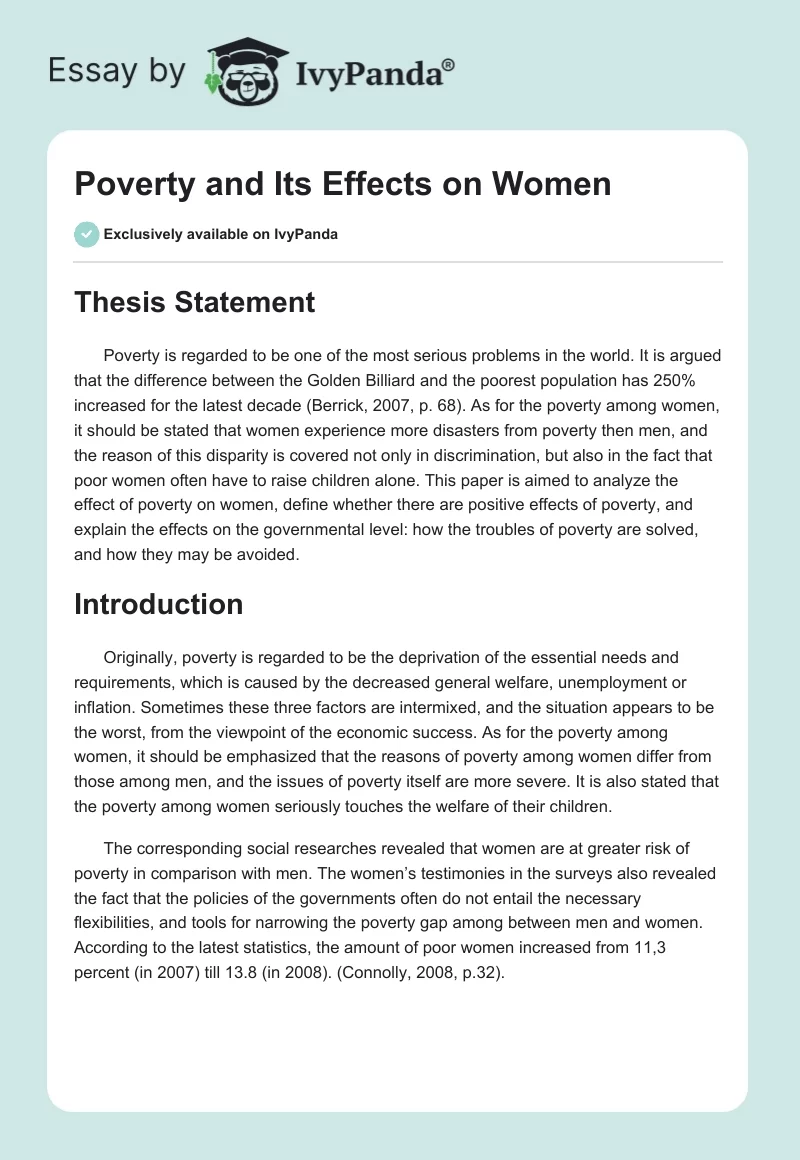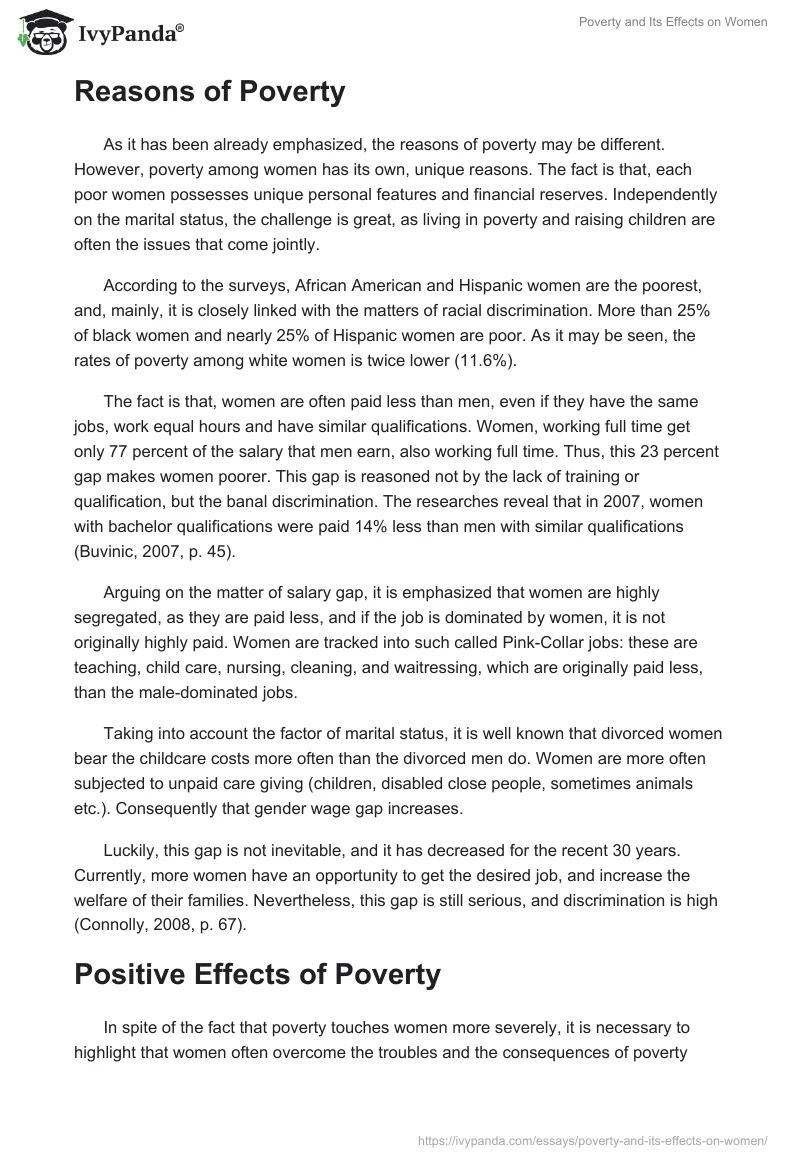Thesis Statement
Poverty is regarded to be one of the most serious problems in the world. It is argued that the difference between the Golden Billiard and the poorest population has 250% increased for the latest decade (Berrick, 2007, p. 68). As for the poverty among women, it should be stated that women experience more disasters from poverty then men, and the reason of this disparity is covered not only in discrimination, but also in the fact that poor women often have to raise children alone. This paper is aimed to analyze the effect of poverty on women, define whether there are positive effects of poverty, and explain the effects on the governmental level: how the troubles of poverty are solved, and how they may be avoided.
Introduction
Originally, poverty is regarded to be the deprivation of the essential needs and requirements, which is caused by the decreased general welfare, unemployment or inflation. Sometimes these three factors are intermixed, and the situation appears to be the worst, from the viewpoint of the economic success. As for the poverty among women, it should be emphasized that the reasons of poverty among women differ from those among men, and the issues of poverty itself are more severe. It is also stated that the poverty among women seriously touches the welfare of their children.
The corresponding social researches revealed that women are at greater risk of poverty in comparison with men. The women’s testimonies in the surveys also revealed the fact that the policies of the governments often do not entail the necessary flexibilities, and tools for narrowing the poverty gap among between men and women. According to the latest statistics, the amount of poor women increased from 11,3 percent (in 2007) till 13.8 (in 2008). (Connolly, 2008, p.32).
Reasons of Poverty
As it has been already emphasized, the reasons of poverty may be different. However, poverty among women has its own, unique reasons. The fact is that, each poor women possesses unique personal features and financial reserves. Independently on the marital status, the challenge is great, as living in poverty and raising children are often the issues that come jointly.
According to the surveys, African American and Hispanic women are the poorest, and, mainly, it is closely linked with the matters of racial discrimination. More than 25% of black women and nearly 25% of Hispanic women are poor. As it may be seen, the rates of poverty among white women is twice lower (11.6%).
The fact is that, women are often paid less than men, even if they have the same jobs, work equal hours and have similar qualifications. Women, working full time get only 77 percent of the salary that men earn, also working full time. Thus, this 23 percent gap makes women poorer. This gap is reasoned not by the lack of training or qualification, but the banal discrimination. The researches reveal that in 2007, women with bachelor qualifications were paid 14% less than men with similar qualifications (Buvinic, 2007, p. 45).
Arguing on the matter of salary gap, it is emphasized that women are highly segregated, as they are paid less, and if the job is dominated by women, it is not originally highly paid. Women are tracked into such called Pink-Collar jobs: these are teaching, child care, nursing, cleaning, and waitressing, which are originally paid less, than the male-dominated jobs.
Taking into account the factor of marital status, it is well known that divorced women bear the childcare costs more often than the divorced men do. Women are more often subjected to unpaid care giving (children, disabled close people, sometimes animals etc.). Consequently that gender wage gap increases.
Luckily, this gap is not inevitable, and it has decreased for the recent 30 years. Currently, more women have an opportunity to get the desired job, and increase the welfare of their families. Nevertheless, this gap is still serious, and discrimination is high (Connolly, 2008, p. 67).
Positive Effects of Poverty
In spite of the fact that poverty touches women more severely, it is necessary to highlight that women often overcome the troubles and the consequences of poverty braver than men do. Originally, women’s mind is more powerful, as they often have more reasons to live, and often have someone to take care of. Thus, women realize that someone else depends on them, and women often have more motivations to overcome the consequences and disasters of poverty.
Women who were not always poor struggle for the re-achievement of the welfare even more severely, as they feel the necessity and obligation to restore the wellbeing of their families. Those, who lost their jobs, and appeared at the poverty line are ready for almost everything in order to save the family life and the wellbeing of the family. They agree for physical and low paid jobs, if there are no other alternatives, they get employed for two or even three jobs, work over time and night shifts.
The stresses and constant loads (moral or physical) may have positive effects, as women may lose some weight, and achieve the perfect physical condition. Thus, when the disaster finishes, a women may have an improved figure, that she has always dreamt for. Poverty changes the view of the surrounding world, and often causes the changes in the attitude to other people. Anyway, overcoming difficulties is the life experience, that is the most precious thing in this life, as basing on the life experience people plan their further life, and try not to drop the same brick the next time.
Another fact, that may be attributed to positive effects of poverty among women, is that there are more homeless men, than women. Taking into consideration, that the percentage of poverty among women is higher than among men, this indicator is rather impressive. Consequently, it only confirms the statement, that women overcome the consequences and disaster of poverty more bravely.
Negative Effects
Poverty may have the opposite effect, and quite different reasons, if a women does not have anyone to give care to. These women are more subjected to drug and alcohol addiction, they ma commit suicide, or participate in street gangs. This effect changes to opposite depending on a factor of care giving, as the very nature of women is based on care giving.
The stories, that are represented in novels, movies, either real or fictional represent the women, who struggle for their own, and their families’ wellbeing. Surely, if there is a family – there is strong motivation for taking care of it, and these women do everything possible to overcome poverty. Surely, there are also the exceptions, however these women are deprived the parents’ rights, and, finally, they do not have anyone to take care of, except pets.
Poverty among women frequently causes high rates of poverty among children. This mainly relates the latter examples, as children of the parents, whose parental rights were deprived, often do not wish to stay in the children’s houses, and escape to live in streets. This is the reason of children’s prostitution, high rates of death among children and, surely, crime among children (Dujon, 2006, p. 15).
As for the effects, which are not associated with family and care giving, there may be the effects, closely linked with health, fitness, appearance and others. Originally, poor people eat worse food than the others, as they can not afford the balanced healthy diet. Consequently, these people (not only women) gain or lose weight, acquire deceases such as tuberculosis, ulcer, skin deceases and others, closely linked with nutrition and living conditions. Most people move to cheaper apartments in order to be able to pay for them. It causes the psychological stress, which may give impulse for the development of some concealed decease. The new environment may contain offending allergens, parasites or other decease transmitting insects. The increased stress, long-lasting hunger, unfavorable environment may cause the stopping of the women’s reproductive function, and cause other serious damages to health.
Effects on the Governmental Level
Poverty, as the national disaster requires the governmental solution, in order to have the essential effect. These solutions are often reasoned in the law projects, that include the child, unemployment allowances, allowances to mothers of large families and others. These are the significant attempts to overcome the poverty, however, they are often reasoned by the increased rates of poverty, as there is generally no need to pay allowances, if the rates are not too high. When the rates increase, the people become more unsatisfied, and government is forced to restore the financial balance by paying allowances.
These issues always reason the appearance of the corresponding legislative basement and the necessary experience for creating the further laws associated with the increase of welfare of the peoples (Dujon, 2006, p. 24).
The high rates of poor women reason the appearing of special hospitals, where the women may be granted qualified and free of charge medical assistance, especially if a woman has a suckling baby. Poor women are treated as the people entitled to special benefits, and have the advantages in employment, healthcare, legislative maintenance and other spheres of life. These women may buy the goods for the reduced prices, especially if they need to feed a kid, or several children.
Avoiding Poverty
The fact is that, poverty may be avoided, if both sides (citizens and government) are strongly intended to avoid it. Citizens should reasonably follow their finances and follow the financial situation in the country. Shortly, it is necessary not to spend money flippantly. The government, in its turn, should steadily develop the economy of the state, and do everything in order to increase the welfare of the majority of the citizens. Thus, the mutually supported actions may help to avoid poverty. However, there are still countries in the world, where the governments are not interested in the welfare of their peoples. Citizens of these States are obliged to everything in order to keep their families, and sometimes they commit crimes, or sell their organs for illegal transplantations. Poor women in these countries often do not have an opportunity to mind the rules of hygiene, and their children are often born with the inborn deficiencies, or serious deceases.
Conclusion
The effect of poverty on women may be either positive or negative. Actually, the positive impact is often indirect, and is often associated with the health or some benefits offered at the governmental level. As for the negative, they are also mainly indirect, and relate the issues of health, parental rights, living environment and stresses. Originally, all the consequences may be overcome, and the statistics show, that women are more powerful in overcoming the difficulties of poverty than men, and, it is necessary to mention that women often have more motivations to go on living, as they have someone to live for. Care giving is the women’s nature, and this nature helps them to minimize the negative effects of poverty and survive during the disasters.
Finally, it is necessary to emphasize, that minimizing of the effects, that poverty may have, is the task of both sides – citizens, and government, as only joint actions and strong determination may solve this serious problem.
References
- Berrick, Jill Duerr. Faces of Poverty: Portraits of Women and Children on Welfare. New York: Oxford University Press, 2007.
- Buvinic, Mayra. “Women in Poverty: A New Global Underclass.” Foreign Policy 2007: 38
- Connolly, Deborah R. Homeless Mothers: Face to Face with Women and Poverty. Minneapolis: University of Minnesota Press, 2008.
- Dujon, Diane, and Ann Withorn, eds. For Crying out Loud: Women’s Poverty in the United States. Boston: South End Press, 2006.


